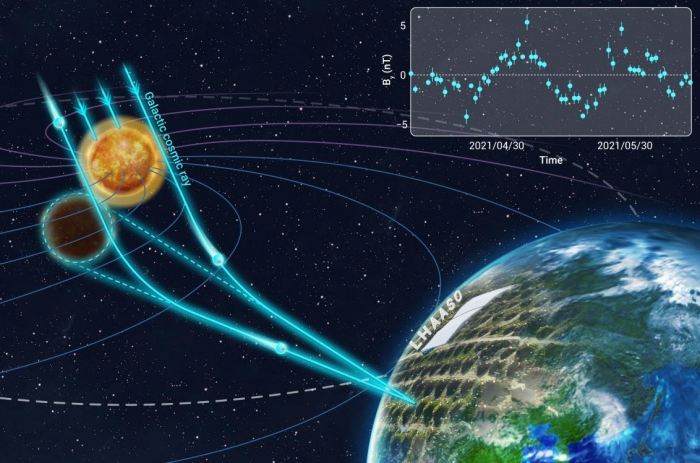LHAASO Realize Daily Monitoring of Interplanetary Magnetic Field between Earth and Sun using Galactic Cosmic Rays
The Large High Altitude Air Shower Observatory (LHAASO) has realized daily monitoring of the interplanetary magnetic field between the Earth and the Sun for the first time. This was accomplished by precisely measuring the subtle changes in the shadow formed by solar occlusion of Galactic cosmic rays due to solar activity. The findings capture changes in the interplanetary magnetic field 3.3 days earlier than observations made by satellites near Earth's orbit. Additionally, this result challenges traditional models of the interplanetary magnetic field, injecting new vitality into research and monitoring of the space environment. This achievement was published in The Innovation on Sept. 27. The research was conducted by the LHAASO collaboration led by the Institute of High Energy Physics (IHEP) of the Chinese Academy of Sciences. Dr. NAN Yuncheng and Prof. CHEN Songzhan from IHEP, and Prof. FENG Cunfeng from Shandong University are the corresponding authors of the paper.
The Sun, as the primary energy source for life on Earth, continually influences the planet's environment. With advancements in human technology and the increasing use of electronic and space equipment, the impact of solar activity on humanity is gradually being amplified. Consequently, monitoring solar activity and forecasting space weather between the Earth and the Sun have become important areas of scientific research. The interplanetary magnetic field extends from the Sun's magnetic field into interplanetary space. For a long time, humans have primarily monitored solar surface activity using coronagraphs, combining this data with measurements from ground-based and spacecraft instruments to study variations in the interplanetary magnetic field and predict the disturbances these changes may cause in the Earth's magnetic field, commonly referred to as space weather forecasting. However, within the vast interplanetary space between the Earth and the Sun, monitoring methods have always been a weak link in the overall monitoring system, struggling to provide a complete and instantaneous picture of changes in the interplanetary magnetic field. Clearly, this information is essential for effective monitoring and forecasting of the space environment.
Galactic cosmic rays are primarily composed of positively charged high-energy particles that collide with Earth at speeds close to the speed of light from all directions. The Sun acts like an umbrella, shielding these high-energy particles and creating a shadow known as the "Sun shadow." Cosmic rays take only eight minutes to travel from the Sun to Earth, during which they are deflected by the varying magnetic fields in the space between the Earth and the Sun. Therefore, the movement of the Sun shadow can trace the deflection of cosmic rays, and these cosmic rays act as probes that can "diagnose" the strength and changes in the magnetic field in the space between the Earth and the Sun.
Previously, while cosmic ray detection arrays could observe the Sun shadow, limitations in the sensitivity of these arrays prevented them from accurately measuring the shadow using data from the same day. However, LHAASO, with its exceptional high sensitivity, has achieved real-time daily observations of this phenomenon for the first time. Researchers successfully measured the intensity and variations of the interplanetary magnetic field on a daily basis from March to October 2021 (as shown in Figure 1), using the information on the daily movement of the Sun shadow's position. They found that these measurements are 3.31 ± 0.12 days ahead of those obtained by spacecraft near Earth, providing a new method for long-term monitoring of the interplanetary magnetic field and its changes. This advances our understanding of the interplanetary magnetic field over large distances between the Earth and the Sun, injecting new vitality into space environment research and forecasting. Furthermore, the 3.31-day lead time also challenges traditional models of the interplanetary magnetic field, such as the Parker model, which predicted a lead time of only 2.06 ± 0.04 days.

Figure 1: LHAASO utilizes the cosmic ray Sun shadow to measure the interplanetary magnetic field between the Earth and the Sun, illustrating the intensity of the interplanetary magnetic field near Earth and its changes over time, with measurements captured 3.3 days in advance. (Image by IHEP)
LHAASO is located at an altitude of 4,410 meters on Haizi Mountain in Daocheng County, Sichuan Province, and it has been in stable operation since July 2021. It is one of the leading cosmic ray detection devices in the world. The LHAASO collaboration has achieved significant results in various fields of physics based on data from the LHAASO experiment, and this discovery marks its first important achievement in the application of cosmic ray research. The research has been funded by the National Natural Science Foundation, the Postdoctoral Science Foundation and so on.
The online paper is:https://doi.org/10.1016/j.xinn.2024.100695
